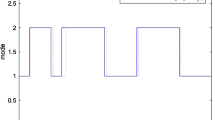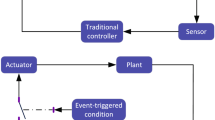Abstract
This paper investigates the problem of dynamic event-triggered dissipative filtering for T–S fuzzy systems. First, a novel dynamic event-triggered mechanism (DETM) is proposed to save communication resources, and it is equipped with two dynamic trigger thresholds. One of the thresholds is a state-dependent time-varying threshold, which is adjusted to the output error. The other is an additional dynamic auxiliary variable, which is described by a differential equation. The DETM makes communication data be transmitted periodically to reduce computation and communication resources. Second, based on the proposed DETM, a new event-triggered reliable dissipative filter is designed to subject to the asynchronous constraint of the membership function. By constructing the Lyapunov function, sufficient conditions are developed to ensure asymptotic stability and strict dissipativity of the filtering error system. Finally, the given simulation example shows the effectiveness of the proposed method.






Similar content being viewed by others
Explore related subjects
Discover the latest articles, news and stories from top researchers in related subjects.Data Availability
The authors declare that the theoretical method of this paper is original, and the used data in the simulation is available, which refers to [28].
References
Yaman, T., Akkartal, G.R.: How warehouse location decisions changed in medical sector after pandemic? A fuzzy comparative study. J. Fuzzy. Ext. Appl. 3(1), 81–95 (2022)
Dirik, M.: Detection of counterfeit banknotes using genetic fuzzy system. J. Fuzzy. Ext. Appl. 3(4), 302–312 (2022)
Abbasimehr, H., Alizadeh, S.: A novel genetic algorithm based method for building accurate and comprehensible churn prediction models. Int. J. Res. Ind. Eng. 2(4), 1–14 (2013)
Meslameni, W., Kamoun, T.: Detection of an imbalance fault by vibration monitoring: case of a screw compressor. J. Appl. Res. Ind. Eng. 8(1), 27–39 (2021)
Bulut, U., Ozceylan, E.: Application of the fuzzy inference system to evaluate the quality of air textured warp yarn. J. Fuzzy. Ext. Appl. 3(1), 31–44 (2022)
Arora, S.R.V., Chugh, B.: A decision-making system for corona prognosis using fuzzy inference system. J. Fuzzy. Ext. Appl. 2(4), 344–354 (2021)
Umoh, U., Udoh, A.A.S., Abdulzeez, A.: Interval type-2 fuzzy logic system for remote vital signs monitoring and shock level prediction. J. Fuzzy. Ext. Appl. 2(1), 41–68 (2021)
Taghavifar, H., Mardani, C.H.A., Qin, Y.: Adaptive robust nonlinear active suspension control using an observer-based modified sliding mode interval type-2 fuzzy neural network. IEEE Trans. Intelli. Vehi. 5(1), 53–62 (2020)
Wang, L., Lam, H.K.: \(h_{\infty }\) control for continuous-time takagi-sugeno fuzzy model by applying generalized lyapunov function and introducing outer variables. Automatica 125, 109409 (2021)
Lendek, Z., Lauber, T.M.G.R.B.J., Schutter, B.D.: Adaptive observers for t-s fuzzy systems with unknown polynomial inputs. Fuzzy Sets Syst. 165(15), 2043–2065 (2010)
Feng, G.: A survey on analysis and design of model-based fuzzy control systems. IEEE Trans. Fuzzy Syst. 14(5), 676–697 (2006)
Wang, L., Liu, J., Lam, H.K.: Further study on stabilization for continuous-time takagi-sugeno fuzzy systems with time-delay. IEEE Trans. Cybern. 51(11), 5637–5643 (2021)
Han, H., Zhang, X., Zhang, W.: Finite-time dissipative filtering for uncertain discrete-time systems with state and disturbance-dependent noise over fading channels. ISA Trans. 86, 134–143 (2019)
Su, L., Ye, D.: Mixed \(h_\infty \) and passive event-triggered reliable control for t-s fuzzy markov jump systems. Neurocomputing 281, 96–105 (2018)
Li, T., Deng, F., Fu, J., Chai, T.: Stabilization of switched linear neutral systems: an event-triggered sampling control scheme. IEEE Trans. Automat. Contr. 63(10), 3537–3544 (2018)
Li, H., Gao, H., Zuo, Z., Liu, J.: Security control based on variable-step predictive approach for networked control system with denial-of-service attacks. Int. J. Robust Nonlinear Control 33(14), 8475–8489 (2023)
Wang, X., Ding, D., Ge, X., Dong, H.: Neural-network-based control with dynamic event-triggered mechanisms under dos attacks and applications in load frequency control. IEEE Trans. Circuits Syst. I Regul. Pap. 69(12), 5312–5324 (2022)
Li, Z., Ma, D., Zhao, J.: Dynamic event-triggered \(l_{\infty }\) control for switched affine systems with sampled-data switching. Nonlinear Anal. Hybrid Syst. 39, 100978 (2021)
Shu, F., Zhai, J.: Dynamic event-triggered output feedback control for a class of nonlinear systems with time-varying delays. Inform. Sci. 569, 205–216 (2021)
Liu, D., Yang, G.: Dynamic event-triggered control for linear time-invariant systems with \(l_{2}\)-gain performance. Int. J. Robust Nonlinear Control 29, 507–518 (2019)
Cao, L., Pan, Y., Liang, H., Huang, T.: Observer-based dynamic event-triggered control for multiagent systems with time-varying delay. IEEE Trans. Cybern. 53(5), 3376–3387 (2022)
Xu, W., He, W., Ho, D.W., Kurths, J.: Fully distributed observer-based consensus protocol: adaptive dynamic event-triggered schemes. Automatica 139, 110188 (2022)
Wang, J., Liu, J., Zhang, G., Guo, S.: Periodic event-triggered sliding mode control for lower limb exoskeleton based on human-robot cooperation. ISA Trans. 123, 87–97 (2021)
Aranda-Escolastico, E., Colombo, L.J., Guinaldo, M.: Periodic event-triggered targeted shape control of lagrangian systems with discrete-time delays. ISA Trans. 117, 139–149 (2021)
Zheng, S., Shi, P., Agarwal, R.: Periodic event-triggered output regulation for linear multi-agent systems. Automatica 122, 109223 (2020)
Chen, Z., Zhang, H., Liu, J.: Adaptive prescribed settling time periodic event-triggered control for uncertain robotic manipulators with state constraints. Neural Netw. 166, 1–10 (2023)
Su, Y., X.Y., Shi, P.: Consensus-based vehicle platoon control under periodic event-triggered strategy. IEEE Trans. Syst. Man Cybern. Syst. (2023)
Liu, Y., Guo, B.Z., Park, J.H., Lee, S.: Event-based reliable dissipative filtering for t-s fuzzy systems with asynchronous constraints. IEEE Trans. Fuzzy Syst. 26(4), 2089–2098 (2017)
Wang, P., Yang, G., Pan, Y.: Event-triggered reliable dissipative filtering for nonlinear networked control systems. Neurocomputing 360, 120–130 (2019)
Li, F., Du, C., Yang, C., Wu, L., Gui, W.: Finite-time asynchronous sliding mode control for markovian jump systems. Automatica 109, 108503 (2019)
Du, C., Yang, C., Li, F., Shi, P.: Asynchronous output feedback control for fuzzy markovian jump systems via sliding mode. J. Frankl. Inst. 356(16), 8952–8970 (2019)
Li, F., Zhang, X., Li, X., Yang, C.: Asynchronous filtering for delayed markovian jump systems via homogeneous polynomial approach. IEEE Trans. Automat. Contr. 65(5), 2163–2170 (2020)
Tian, Y., Yan, H., Zhang, H., Cheng, J., Shen, H.: Asynchronous output feedback control of hidden semi-markov jump systems with random mode-dependent delays. IEEE Trans. Automat. Contr. 67(8), 4107–4114 (2022)
Tian, Y., Wang, Z.: Asynchronous extended dissipative filtering for t-s fuzzy markov jump systems. IEEE Trans. Syst. Man Cybern. Syst. 52(6), 3915–3925 (2021)
Zhang, Q., Yan, H., Wang, M., Li, Z., Chang, Y.: Asynchronous fault detection filter design for t-s fuzzy singular systems via dynamic event-triggered scheme. IEEE Trans. Fuzzy Syst. 31(3), 970–981 (2022)
Sakthivel, R., Sathishkumar, M., Mathiyalagan, K.: Robust reliable dissipative filtering for markovian jump nonlinear systems with uncertainties. Int. J. Adapt. Control Signal Process. 31, 39–53 (2017)
Coutinho, P.H., Palhares, R.M.: Dynamic periodic event-triggered gain-scheduling control co-design for quasi-lpv systems. Nonlinear Anal. Hybrid Syst. 41, 101044 (2021)
Hu, C., Ding, S., Xie, X.: Event-based distributed set-membership estimation for complex networks under deception attacks. IEEE Trans. Autom. Sci. Eng. https://doi.org/10.1109/TASE.2023.3284448
Bourahala, F., Guelton, K., Manamanni, N.: Relaxed controller design conditions for takagi-sugeno systems with state time-varying delays. Int. J. Fuzzy Syst. 19, 1406–1416 (2017)
Peng, C., Yue, D., Fei, M.R.: Relaxed stability and stabilization conditions of networked fuzzy control systems subject to asynchronous grades of membership. IEEE Trans. Fuzzy Syst. 22(5), 1101–1112 (2014)
Zhang, B., Zheng, W.X., Xu, S.: Filtering of markovian jump delay systems based on a new performance index. IEEE Trans. Circuits Syst. I Regul. Pap. 60(5), 1250–1263 (2013)
Park, P., Ko, J., Jeong, C.: Reciprocally convex approach to stability of systems with time-varying delays. Automatica 47, 235–238 (2011)
Funding
This work was supported in part by the National Natural Science Foundation of China under Grants 62373133 and the S & T Program of Hebei 21567698 H.
Author information
Authors and Affiliations
Corresponding author
Rights and permissions
Springer Nature or its licensor (e.g. a society or other partner) holds exclusive rights to this article under a publishing agreement with the author(s) or other rightsholder(s); author self-archiving of the accepted manuscript version of this article is solely governed by the terms of such publishing agreement and applicable law.
About this article
Cite this article
Hu, C., Ding, S. A Novel Dynamic Event-Triggered Dissipative Filtering for T–S Fuzzy Systems with Asynchronous Constraints. Int. J. Fuzzy Syst. 26, 2407–2418 (2024). https://doi.org/10.1007/s40815-024-01693-4
Received:
Revised:
Accepted:
Published:
Issue Date:
DOI: https://doi.org/10.1007/s40815-024-01693-4




